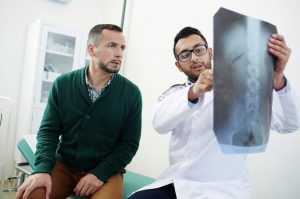Total Hip Replacement
During total hip replacement surgery, our surgeons remove the ball and socket of the damaged hip joint and replace them with artificial implants. The goal of the procedure is to relieve pain and improve the range of motion for patients dealing with chronic issues such as arthritis or hip fractures.
Reasons for Hip Replacement
The most common reason to undergo a total hip replacement procedure is due to arthritis. This condition, including age-related osteoarthritis and the autoimmune condition rheumatoid arthritis, can cause extensive hip damage. The hip joint consists of the ball of the hip (upper femur) and the hip socket (acetabulum) in the pelvis.
Arthritis is an inflammation of the hip that occurs when the protective layer of cartilage wears down due to age or becomes damaged due to an immune response. A hip joint may be affected by bone-on-bone contact over time, resulting in pain and limited movement.
The majority of cases do not require hip surgery. Conservative treatments and lifestyle adjustments are often effective for symptom management. Patients may be referred to a surgeon for the following reasons:
- Hip pain is severely disruptive to quality of life
- Mobility is limited due to decreased range of motion and pain
- Pain persists when at rest
- Conservative treatments have been exhausted without bringing adequate relief from symptoms
Total Hip Replacement Procedure Overview
Once a surgeon has consulted with the patient and performed an evaluation to determine if they are a good potential candidate for surgery, a total hip replacement procedure will typically consist of the following steps:
- Accessing the hip
- Using precision techniques to remove the very top of the upper femur and replace it with a prosthesis
- Removing damaged tissue from the socket and replacing it with a corresponding implant and spacer
- Resetting the hip and any supporting soft tissue
- The surgeon will close the surgical site
This procedure generally takes one to two hours, however, it can vary depending on the patient. With the help of minimally invasive techniques and advanced surgical technology, this type of surgery can be performed on an outpatient basis which allows for a shorter hospital stay. Patients should expect to undergo physical therapy and rehabilitation in order to help the healing process, rebuild supporting muscles and increase the function of the new hip joint.
Cost
The cost of this procedure varies depending on a range of factors. This includes the extent and location of the surgery, the type of implant, and the patient’s insurance carrier. Patients should be aware that Medicare covers total hip replacement if deemed a necessary part of treatment.
Learn More About Hip Pain Relief
For more information about treatments for hip injuries and conditions that can get you back to an active lifestyle, reach out to BEST Health System today. Our dedicated team can help you create a personalized treatment plan that works for you.
Procedure Doctors
Related Articles
The Seven Benefits of Minimally Invasive Surgery
What is Minimally Invasive Treatment? Minimally invasive surgery is an alternative to traditional surgery that yields better results, quicker recoveries, and fewer hospital visits. This […]
When to Consider a Hip Replacement
Understanding the Need for Hip Replacement Surgery A hip replacement is not always the right answer for all patients suffering from hip pain. Sometimes, there […]
Why You Should Consider a Minimally Invasive Procedure
What is Minimally Invasive Surgery? Prior to medical advancements in the 1980s, traditional procedures, such as open back surgery, were a patient’s only option. Today, […]
Your Guide to Joint Replacement Surgery
Joint pain is very common in many patients, especially those older than 50. Conservative treatment, such as physical therapy, pain medication, rest, etc are often […]



